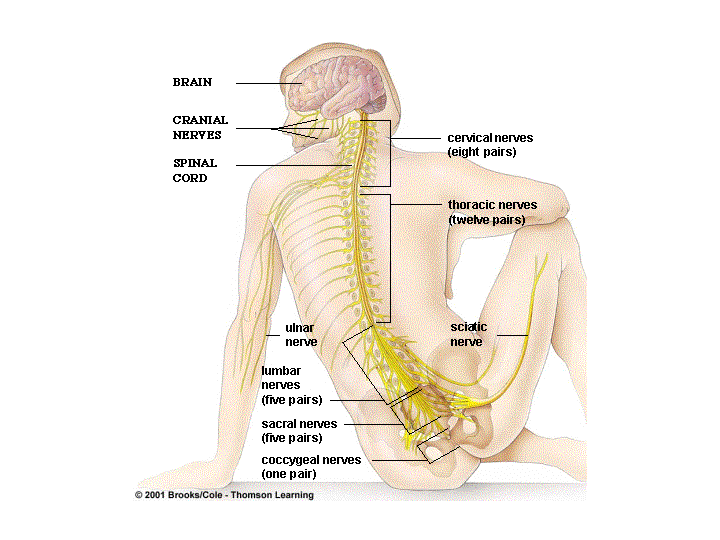
Peripheral Nervous System
The human peripheral system has two types of nerves based on location:
- Spinal nerves (31 pairs) connect with the spinal cord and innervate most areas of the body.
- Cranial nerves (12 pairs) connect vital organs directly to the brain.
Spinal and cranial nerves can also be classified on
the basis of function:
- The somatic nerves relay sensory information from receptors in the skin and muscles and motor
commands to skeletal muscles (voluntary control).
- The autonomic nerves sends signals to and from smooth muscles, internal organs (visceral
functions) cardiac muscle, and glands (involuntary control).
There are two types of autonomic nerves the parasympathetic and sympathetic nerves:
- Parasympathetic nerves tend to slow down body activity when the body is not under stress. They
originate in the brain and the sacral region of the spinal cord. Their ganglia are in walls of
organs. They promote housekeeping responses, such as digestion.
- Sympathetic nerves increase overall body activity during times of stress, excitement, or danger.
They also call on the hormone epinephrine to increase the "fight-flight" response. They originate
in the thoracic and lumbar regions of the spinal cord. Their ganglia are near the spinal cord.
Most organs receive input from both sympathetic and parasympathetic nerves, usually with opposite
effects on the organ. Most organs are continually receiving both sympathetic and parasympathetic
stimulation. For example, sympathetic nerves signal the heart to speed up and parasympathetic
stimulate it to slow down. Which dominates depends on the situation.
The Spinal Cord
The spinal cord is a pathway for signal travel between the peripheral nervous system and the brain.
The cord is also the center for controlling some reflex actions. Sensory and motor neurons make
direct reflex connections in the spinal cord. Spinal reflexes do not involve the brain.
The spinal cord (and also the brain) is covered with tough membranes, the meninges, and resides
within the protection of the stacked vertebrae.
Signals move up and down the spinal cord in bundles
of sheathed axons. The tracts located on the periphery of the spinal cord glisten because of their
myelin sheaths and are called white matter. The central, butterfly-shaped area (in cross-section)
consists of unsheathed axons, dendrites, and cell bodies and is called gray matter.
This animation (Audio - Important) describes the
autonomic nervous system.
PREVIOUS
NEXT
LECTURE 23 INDEX
MAIN INDEX
